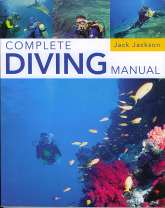 Jackson's Complete Diving Manual is a large format paperback printed on glossy stock and full of color photographs and helpful illustrations and diagrams, ranging from concepts to technical drawings. It's not a picture book, just one that uses graphics and visuals very well to illustrate text. Jackson is an award-winning photographer and advanced diver, and the book also benefitted from input by Scuba Diving Magazine technical editor Michael R. Ange, author of "Diver Down."
Jackson's Complete Diving Manual is a large format paperback printed on glossy stock and full of color photographs and helpful illustrations and diagrams, ranging from concepts to technical drawings. It's not a picture book, just one that uses graphics and visuals very well to illustrate text. Jackson is an award-winning photographer and advanced diver, and the book also benefitted from input by Scuba Diving Magazine technical editor Michael R. Ange, author of "Diver Down."
The Complete Diving Manual is a great and pleasant way to get an idea what scuba diving is all about. It's a rather complete introduction to beginners and newcomers, but contains enough detail and useful reference diagrams that the book has its place in the library of any diver, all the way yo advanced and technical. To give an example: where most general introduction to diving may have brief description of, say, the second stage in a regulator, Jackson provides detailed drawings and diagrams that show and label every part. That way readers can, if they choose, figure out exactly how a piece of equipment works. This approach even extends to more advanced equipment, such as rebreathers. There are full diagrams how a regular scuba unit compares to a semiclosed rebreather and that from a closed-circuit rebreather (where each of 24 parts and systems is shown and labeled). Yet, it never gets dry as everything is accompanied by terific photographs as well.
In terms of overall content, Jackson covers all the basics. What diving is all about, equipment, physiology, training, planning, types of diving, technical diving, safety and dangers, travel, trips, and so on. Type is large and easy to read. It is also logically arranged, and, thankfully, omits the numerous (and often redundant) tips and tricks and bullet points you'd find in the "for Dummies" book on scuba diving that essentially covers all the same points. Jackson simply builds the information into the text itself. Also helpful: a very detailed glossary of diving terms and a listing of all the pertaining agencies and organizations.
The Complete Diving Manual is just that; it provides a total overview of scuba diving and what all it entails. It's all presented in a large format, colorful book that uses a variety of visuals to illustrate, entertain and explain. Want to see the conceptual difference in both basic and balanced diaphragm and piston first stage mechanisms? It's in there, shown in simple, logical graphics. Apart from the methodical and comprehensive description of all aspects of scuba, Jackson's ability to pick just the right visuals to illustrate and explain are the strongest parts of the Complete Diving Manual.
-- C. H. Blickenstorfer






